OnePlus Open vs Google Pixel Fold: How would these compare?
We may earn a commission if you make a purchase from the links on this page.

Intro
While it may seem that the Galaxy Z Fold 5 could be concluding 2023 as far as major foldable releases go, OnePlus would like to have a word with you.
Yep, that's right, the company that's never, never, ever seemingly ready to settle has taken a bold leap in the dynamic foldable space with its own foldable phone. And truth be told, it's a mighty fine first attempt, which definitely serves as a bold statement that OnePlus will play a serious role in the foldable market in the future.
We were impressed with the OnePlus Open, which fared pretty well in our review, making it easily one of our favorite foldables in 2023. Even in 2024, it is still a competitive device that holds its own against even against next-gen foldables.
How does the OnePlus Open fare against the Google Pixel Fold, one of the better foldables released so far in 2023, and one that you might actually use without having to always unfold?
Let's explore how the two foldables might fare against one another!
OnePlus Open vs Google Pixel Fold expectations:
- 7.82-inch OLED 120Hz vs 7.6-inch OLED 120Hz inner display
- Qualcomm Snapdragon 8 Gen 2 vs Google Tensor G2
- 4,805mAh vs 4,821mAh batteries
- 48MP ultra-wide vs 10.8MP ultra-wide camera
- 48MP telephoto vs 10.8MP 5.0x telephoto
Table of Contents:
Read more:
- Google Pixel Fold Review: finally, a folding phone you can enjoy using even without unfolding
- OnePlus Open preview: The industry disruptor is just around the corner!
- Samsung Galaxy Z Fold 5 vs OnePlus Open: Hold some, fold some
- OnePlus Open 2 vs OnePlus Open: A sequel set for success
- OnePlus Open 2 vs Galaxy Z Fold 6: Samsung might be lagging behind
- OnePlus Open 2 vs Pixel 9 Pro Fold: How will the two foldable phones compare?
Design and Size
Some much-needed competition to Samsung
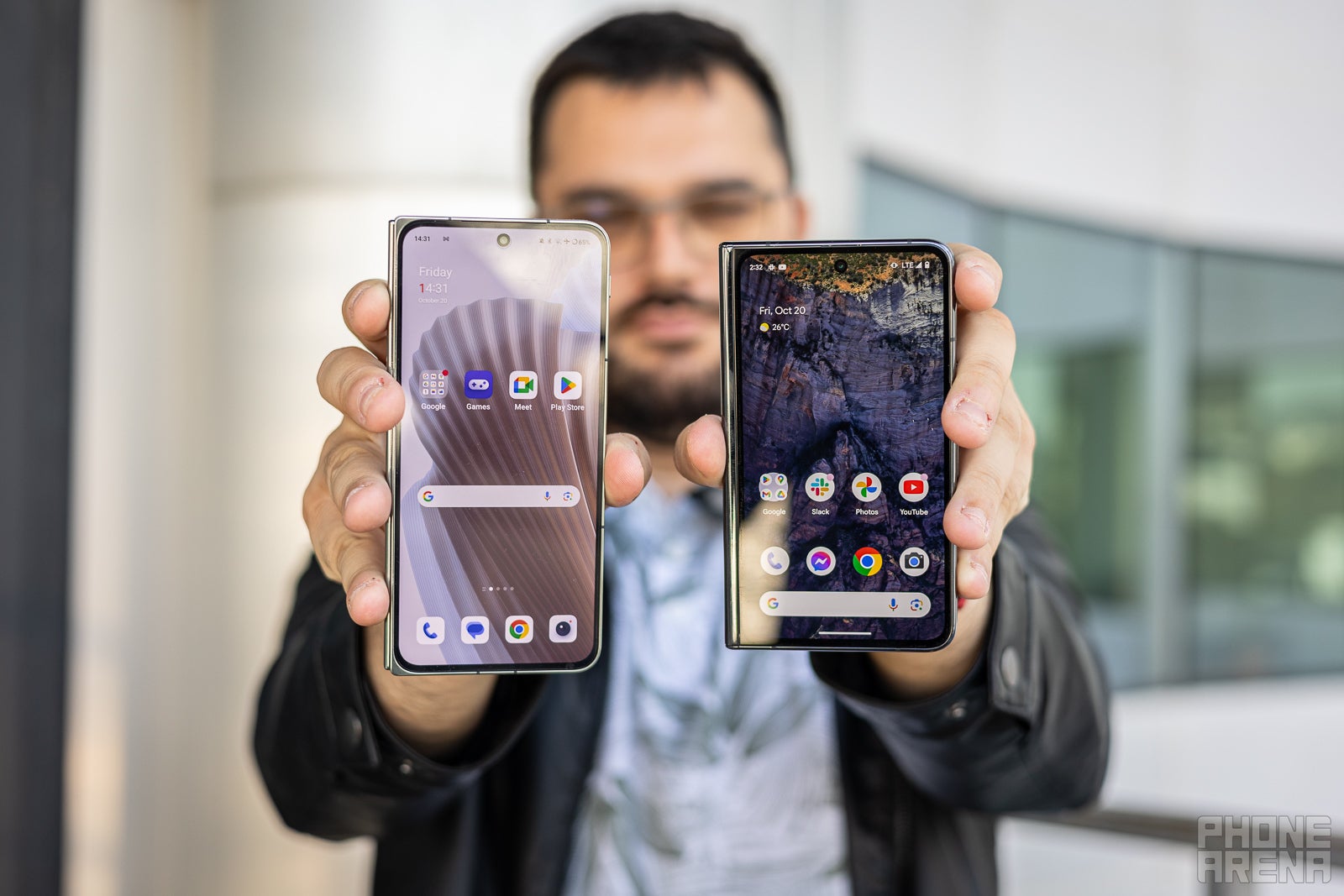
The OnePlus Open is unmistakably a OnePlus device, showcasing the brand’s signature design language in the foldable space. Like the Galaxy Z Fold 5 and Google Pixel Fold, it features an inward-folding design.
One thing that stands out is its weight, or rather the lack of it. At 239g or 245g depending on the version (see the specs table above), the OnePlus Open is significantly lighter than the Pixel Fold, which weighs 283g. However, it falls in a similar range to the Galaxy Z Fold 5, which weighs 253g.
One striking feature of the OnePlus Open is the lack of a pronounced display crease. Sure, you can make out where the OnePlus Open bends in half, but it's a very subtle crease, as flat as they come, the polar opposite of the deep canyons that separate the Pixel Fold's and the Galaxy Z Fold's displays in two.
When it comes to size, the OnePlus Open is a large and wide, with a mostly squarish aspect ratio. The main display measures 7.82 inches, while the outer screen is 6.32 inches. It’s slightly wider than the Galaxy Z Fold 5, making one-handed use a bit more challenging.
However, the upside is that the wider outer screen allows you to use the OnePlus Open much like a standard candy bar phone, reducing the need to unfold it frequently thanks to the ample screen space on the outside. That's great, but isn't unique to the OnePlus Open.
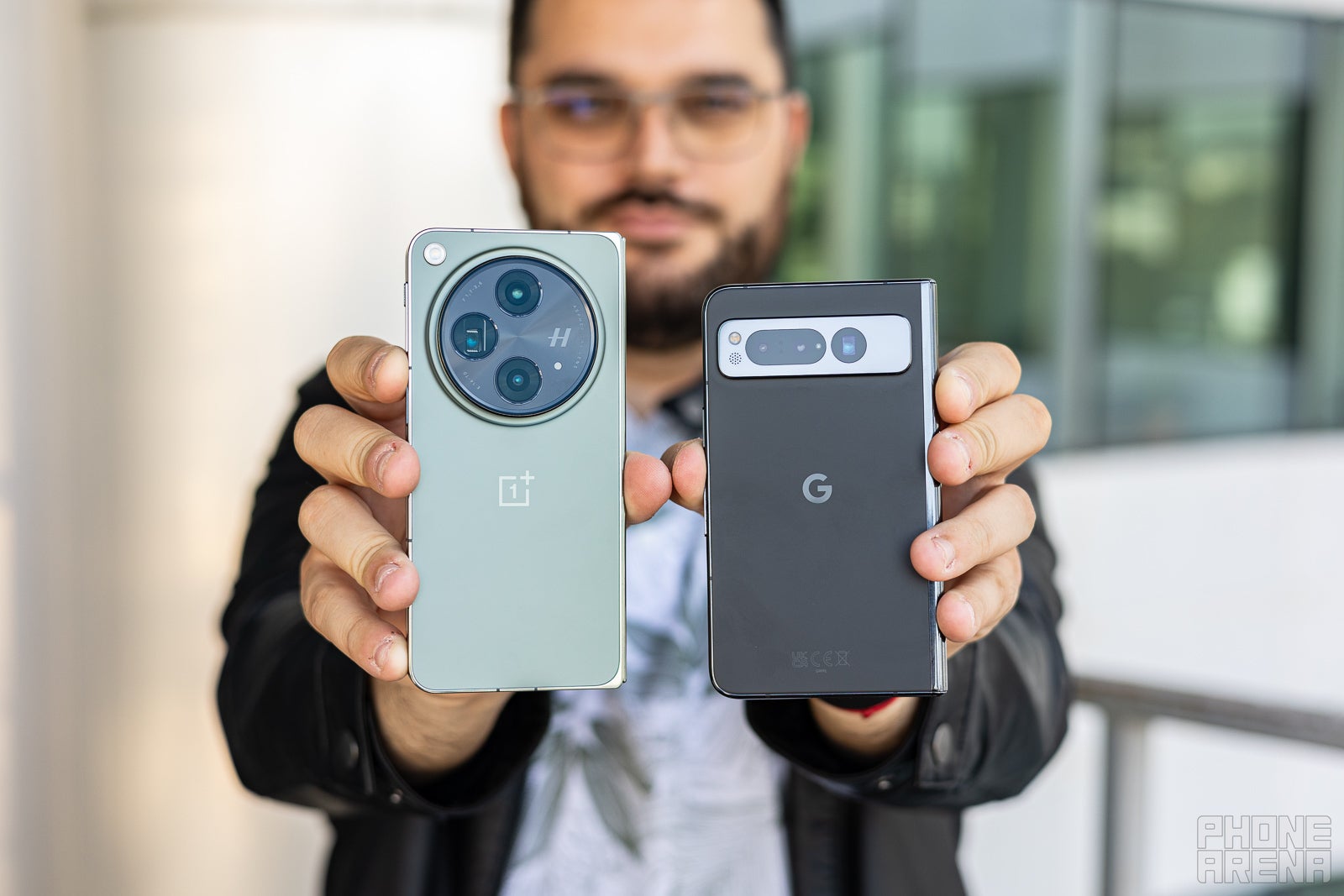
Meanwhile, the Pixel Fold is built like a passport, a sturdy and relatively heavy book-shaped foldable phone with a slightly different form factor than, say, the Galaxy Z Fold series. It's more rectangular in terms of shape, which makes it way easier to use in its folded state.
Although the external 5.8-inch OLED screen might not sound like much, it's actually easier to use than other tall but narrow external displays that are only good for checking notifications.
The Pixel Fold employs a very sturdy hinge that closes with a satisfying sound, but it tips the scales at the humbling 283gr, which is heavier than your regular foldable phone.
There's an IPX8 water-resistance rating associated with the Pixel Fold, which means that it will survive freshwater submersion up to 1.5m for as long as 30 minutes. The OnePlus Open, in contrast, is just IPX4-rated, which means that it can only withstand the occasional splashes, while dunking it in water is a big no-no.
Colors-wise, Google keeps things safe with two color options, Porcelain and Obsidian, which are white and black, respectively. The OnePlus Open comes in Voyager Black and Emerald Dusk colors.
Display Differences
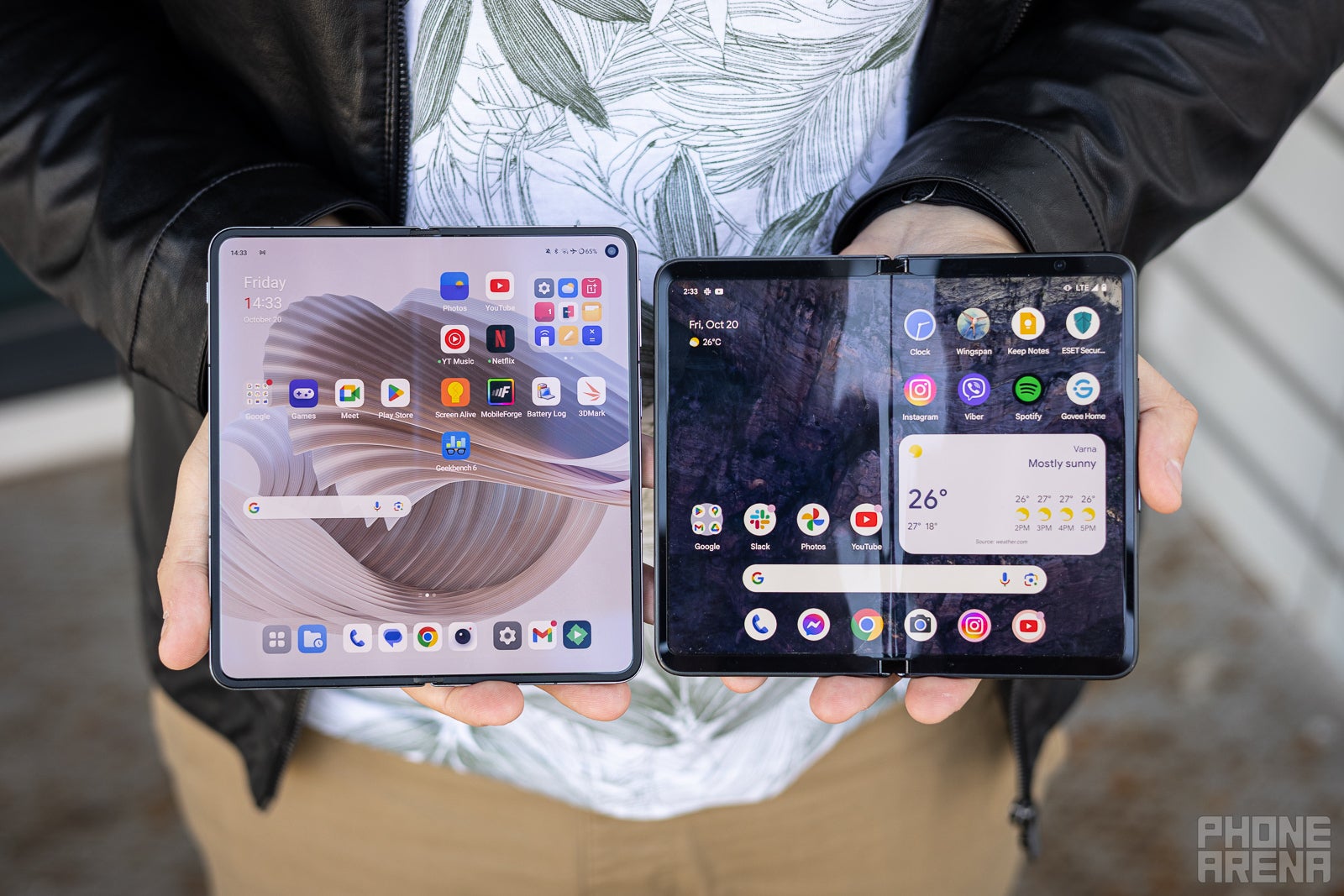
Two gorgeous AMOLED screens (Image by PhoneArena)
The OnePlus Open features a 20:9 outer display measuring 6.31 inches, protected by OnePlus’ Ceramic Guard and a pre-installed screen protector. This external screen is highly functional, as it’s almost as wide as most standard candybar phones, making everyday tasks easy to manage without needing to unfold the device.
Thanks to LTPO 3.0 technology, the outer screen offers a super-smooth experience, dynamically adjusting its refresh rate between 10 and 120Hz for optimal performance.
The inner screen is a large 7.82-inch AMOLED display with more advanced LTPO tech that can go all the way down to 1Hz. This display is covered with Ultra-Thin Glass and also has a factory TPU screen protector for an extra peace of mind.
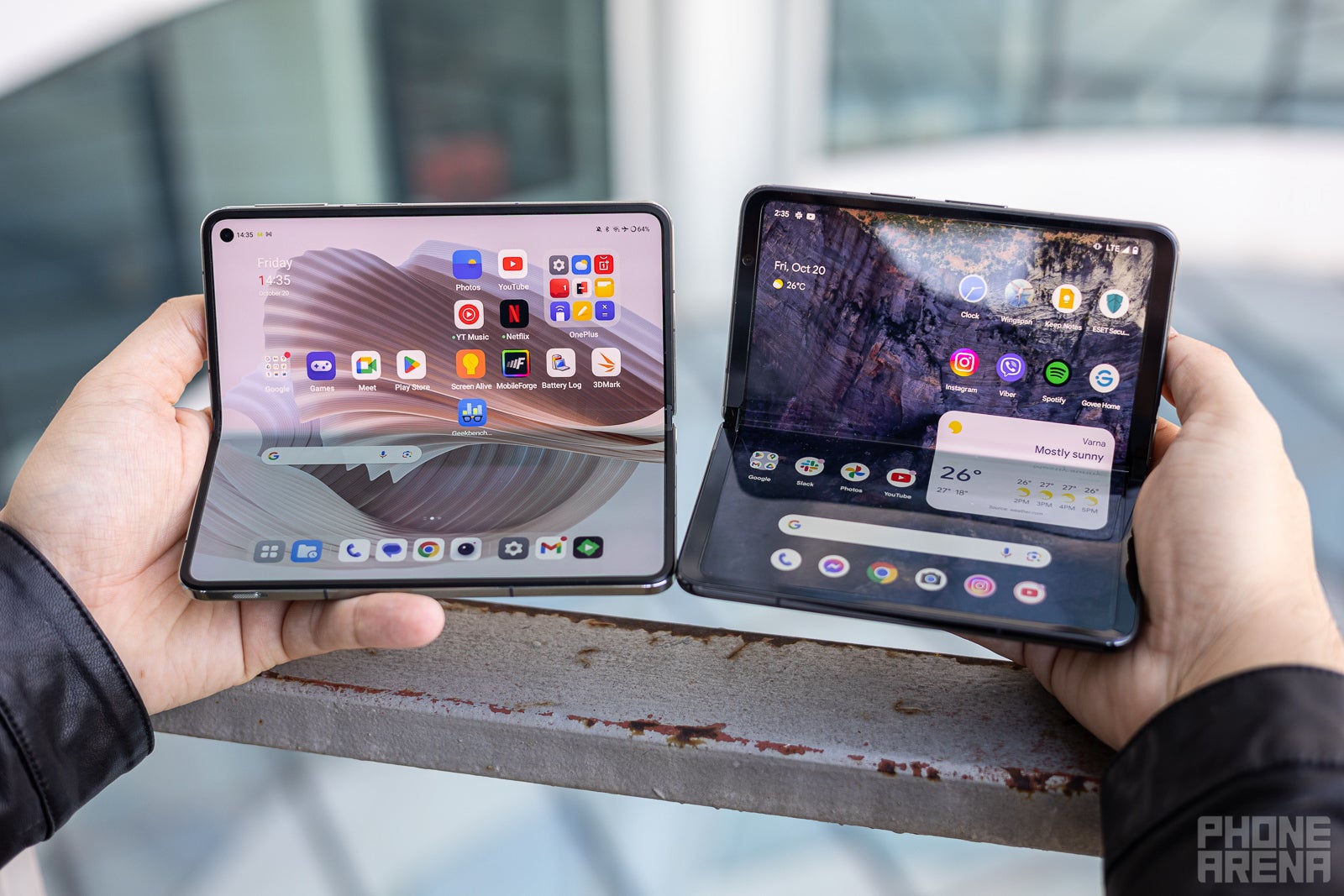
In both folded and unfolded states, the two devices offer lots of versatility (Image by PhoneArena)
The Google Pixel Fold, on the other hand, has a large internal display that makes experiencing content truly a joy. With excellent maximum brightness and excellent color temperature, as well as that very smooth 120Hz scrolling that makes experiencing content so rewarding.
There are some issues, though––the internal display is exceptionally reflective, hurting its outdoors legibility. Additionally, the display is very frail, so anything sharper than a fingernail might permanently scar it.
Display Measurements:
According to our tests, it's an even match between the two displays, with similar minimum and maximum brightness levels. The OnePlus Open is slightly colder in terms of screen properties, while the Pixel Fold is truer to life. The latter has significantly more screen reflections, though.
The OnePlus Open uses a fingerprint scanner embedded in the power key, which is the case with most of its rivals, like the Pixel Fold and the Galaxy Z Fold 5. Those work fast and reliably, so we can't really complain here.
Performance and Software
Snapdragon vs Tensor, a tale as old as 2021
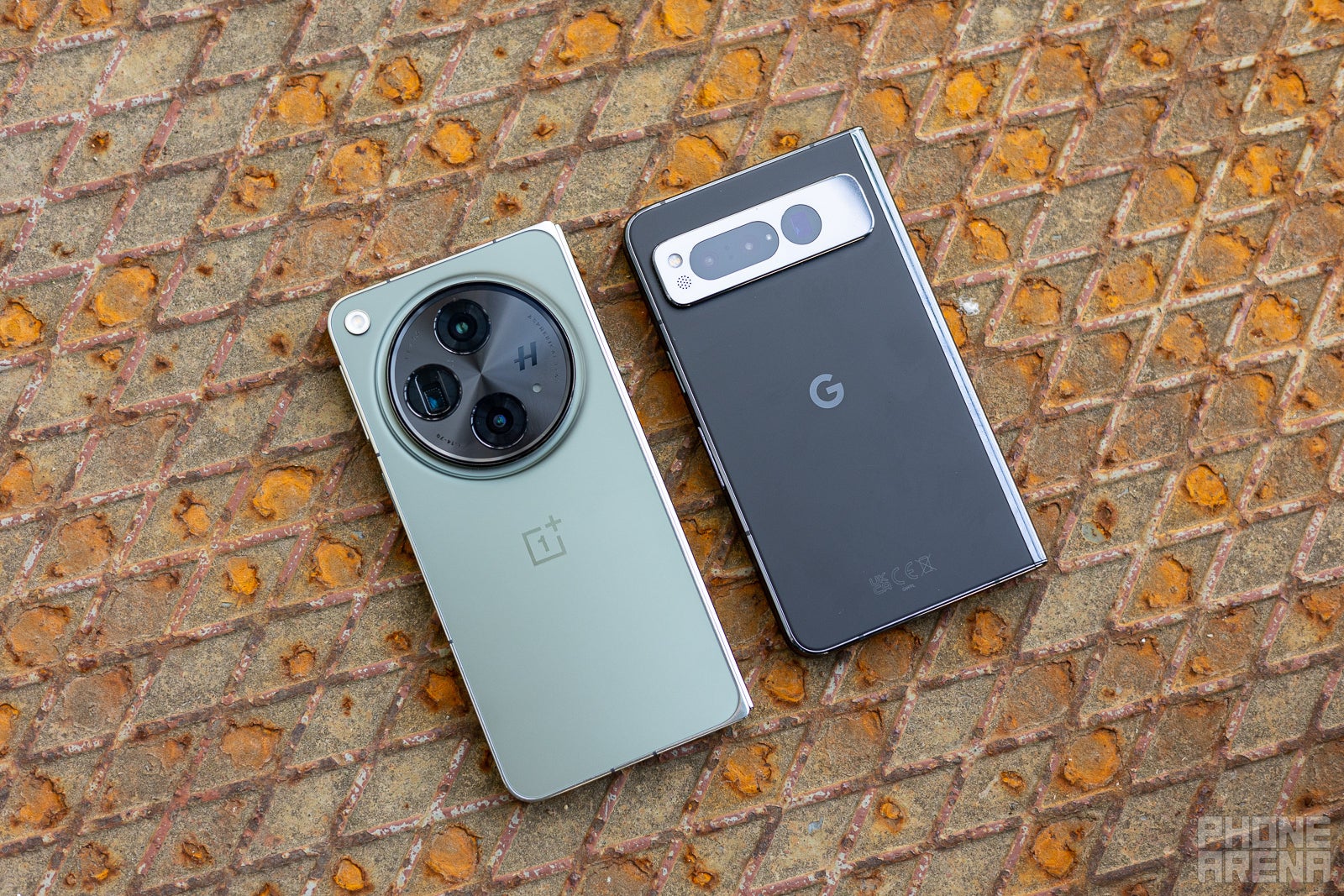
Snapdragon wins once again (Image by PhoneArena)
Ever since Google released its first custom chipset in late 2021, it has shied away from raw performance and put the emphasis on machine learning and artificial intelligence. The Pixel Fold comes with the second generation of the Tensor G2. Yes, the Pixel 7a and the Pixel Fold technically share the same internals, and there's more than a thousand-dollar price difference between the two.
Our Pixel Fold review found that tends to overheat not even during intensive gaming session but also during mundane everyday tasks, which doesn't exactly instill confidence in us. That said, demanding games definitely put a serious strain on the Pixel Fold, so it isn't exactly cut out with gamers in mind.
At the same time, the OnePlus Open arrives with the Qualcomm Snapdragon 8 Gen 2 chip on deck. This former Qualcomm flagship chipset is an efficient powerhouse that not only fares extremely well performance-wise, but also relies on enhanced efficiency.
How does the OnePlus Open fare against the Pixel Fold? Well, unsurprisingly, it's entirely in the OnePlus Open's favor, as the Qualcomm chipset easily lunges forward in terms of synthetic benchmark tests. That's especially true in graphics-intensive tasks, where the OnePlus Open triumphs. However, in real life, it's unlikely that you'll be disappointed with the Pixel Fold's performance.
The Pixel Fold comes along with 12GB of LPDDR5 RAM as well as either 256 or 512GB of UFS3.1 storage, which is consistent with other premium devices in this class. The OnePlus Open comes with 16GB of RAM and 512GB of storage.
Camera
Can OnePlus stir up Google's nest?
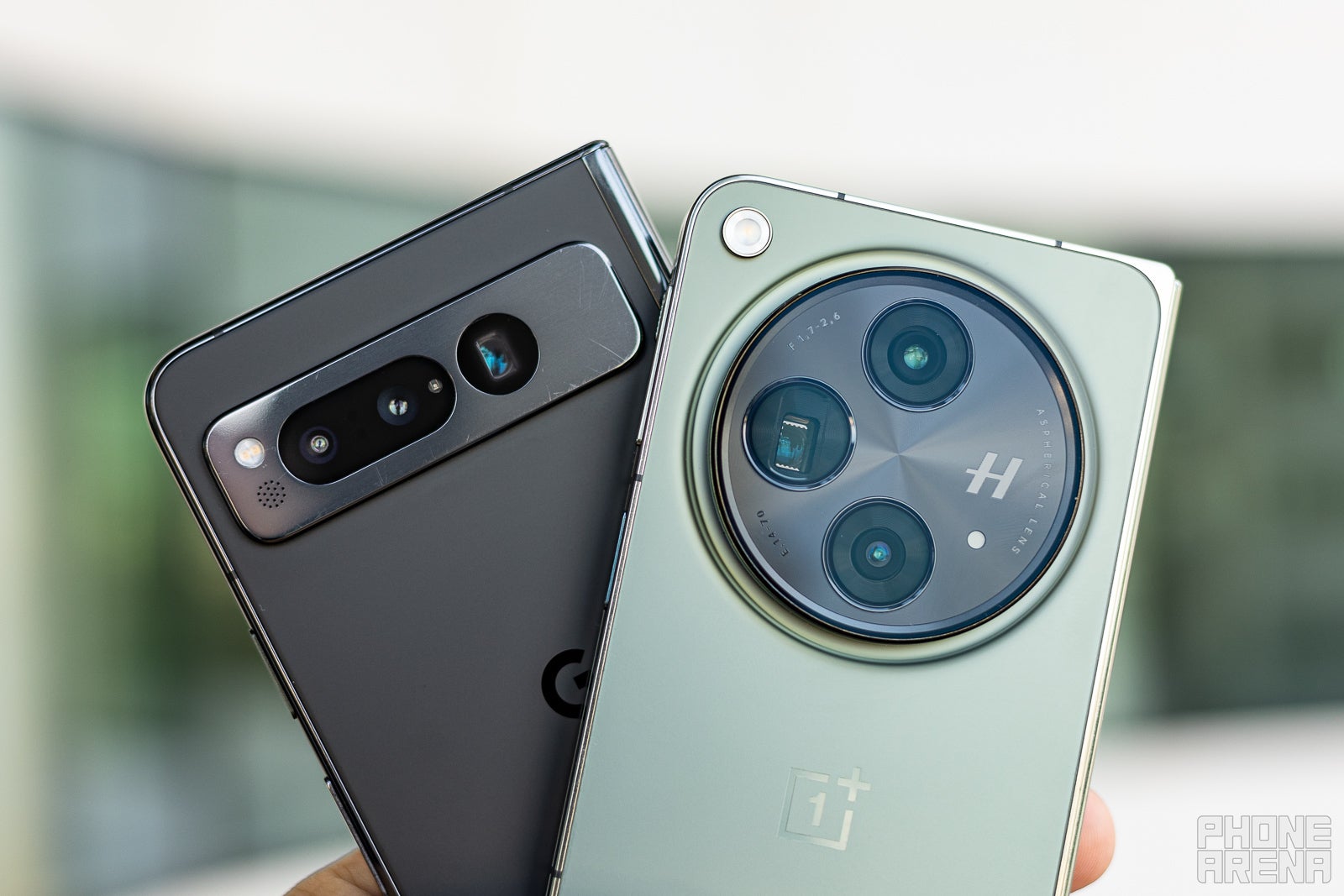
Another win for the OnePlus entrant (Image by PhoneArena)
The OnePlus Open features one of the most impressive camera systems ever seen on a foldable phone, fine-tuned by the renowned camera brand Hasselblad, as is typical for OnePlus flagships. Let’s explore what the OnePlus Open’s camera can do.
The standout rear camera setup includes a 48MP sensor with a large 1/1.43" Sony LYTIA-T808 stacked sensor. This cutting-edge sensor uses an innovative pixel design to capture more light, offering superior dynamic range compared to much larger traditional sensors. OnePlus claims that the main camera on the Open rivals phones with 1-inch sensors, despite its more compact size—an impressive feat.
The telephoto camera boasts a 64MP sensor with 3.0x native optical zoom. Thanks to its high resolution, it can also achieve 6.0x lossless zoom by cropping the center of the sensor. With the ability to zoom up to 120x, this deceptively powerful telephoto lens certainly earns its bragging rights.
The standout rear camera setup includes a 48MP sensor with a large 1/1.43" Sony LYTIA-T808 stacked sensor. This cutting-edge sensor uses an innovative pixel design to capture more light, offering superior dynamic range compared to much larger traditional sensors. OnePlus claims that the main camera on the Open rivals phones with 1-inch sensors, despite its more compact size—an impressive feat.
Simultaneously, the Google Pixel Fold employs a triple-camera setup consisting of a 48MP main camera with a smaller camera sensor than the Pixel 7 Pro, joined by a 10.8MP 5X telephoto and another 10.8MP ultra-wide camera.
Generally speaking, the Pixel Fold successfully captures that unmistakable "Pixel" look, with great dynamic range, many details, as well as decent white balance. Low-light photography suffers in some situations, but nothing too drastic.
What lacks here is the joyous vividness that's often associated with smartphone photos, but that's not a bad thing at all. In fact, the gloomy and realistic Pixel look is easy to like, especially if you're more into realistic image rendition.
PhoneArena Camera Score:
In the custom PhoneArena Camera test, which rigorously tests the camera of each phone in a slew of different tests to gauge its capabilities, it's the OnePlus Open that easily pulls ahead in both still photo and video-recording capabilities.
Battery Life and Charging
Can OnePlus outshine the Pixel Fold?
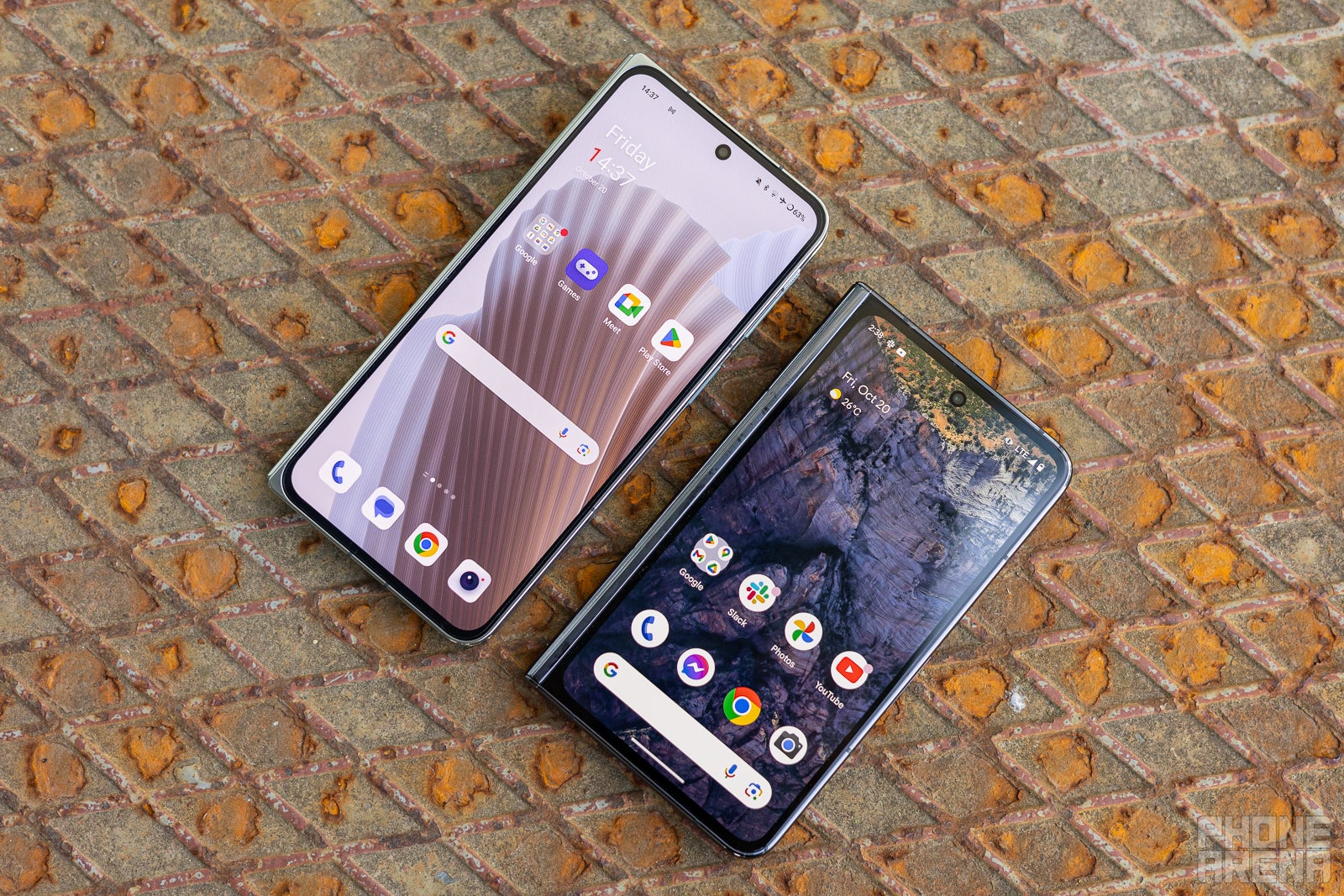
The Pixel Fold comes along with a 4,821mAh battery, which is larger than your average foldable phone, and delivers decent battery endurance. Google cites 24 hours of regular usage and up to three days in low-power mode, and our custom battery tests generally confirm that. Check our complete Pixel Fold review for the full scope on the phone's battery endurance.
Boasting a 4,805mAh battery, which is definitely in the upper tiers when it comes to size, the new OnePlus foldable not only stands its ground against its foldable rivals, like the Google Pixel Fold and the Galaxy Z Fold 5, but also fares very well against regular candybar phones in terms of capacity.
In terms of charging, we have 21W charging support, which isn't terribly fast. The OnePlus Open will most likely follow the years of superfast charging that OnePlus is known for and employ a much faster wired charging solution. Hopefully, we'd see 67W fast charging or possibly more on the OnePlus Open.
PhoneArena Battery and Charging Test Results:
Specs Comparison
Although the OnePlus Open is not official just yet, we already have a dedicated OnePlus Open vs Google Pixel Fold specs comparison page. For your comfort, we've summarized the most essential specs down below.
| Specs | OnePlus Open | Google Pixel Fold |
|---|---|---|
| Size and Weight | Unfolded: 153.4 x 143.1 x 5.8mm (Emerald Dusk) | 153.4 x 143.1 x 5.9mm (Voyager Black) Folded: 153.4 x 73.3 x 11.7mm (Emerald Dusk) | 153.4 x 73.3 x 11.9mm (Voyager Black) Weight: 245gr (Emerald Dusk) | 239gr (Voyager Black) | Folded: 139.7 x 79.5 x 12.1 mm Unfolded: 139.7 x 158.7 x 5.8 mm 283g (10oz) |
| Displays | Main screen: 7.82" AMOLED, 2440x2268, LTPO 3.0 (1-120Hz), sRGB, DCI-P3 Cover screen: 6.31" AMOLED, 2484x1116, LTPO 3.0 (1-120Hz), sRGB, DCI-P3 | Main: 7.6" OLED 10.8:9 ratio 120Hz Cover: 5.8" OLED 17.4:9 ratio |
| Processor | Qualcomm Snapdragon 8 Gen 2 | Google Tensor G2 |
| RAM, Storage and Price | 16GB/256GB | 12/256GB for $1,800 12/512GB for $1,920 |
| Software | Android 14 | Android 1 |
| Cameras | Main: 48MP, f/1.7, Sony LYT-T808 1/1.43" sensor, OIS, EIS, PDAF+CAF Ultrawide: 48MP, f/2.2, Sony IMX581 1/2" sensor, 114-degree FOV, EIS, AF, Macro Telephoto: 64MP, f/2.6, OmniVision OV64B 1/.2" sensor, 3X optical zoom, 6X in-sensor crop, 120X maximum zoom, OIS, EIS, AF Internal selfie camera: 20MP, f/2.2, 1/4" sensor, fixed focus External selfie camera: 32MP, f/2.4, 1/3.14" sensor, fixed focus | Main: 48MP Wide camera, f/1.7 Ultrawide: 10.8MP Ultra, f/2.2 Telephoto: 10.8MP 5X Zoom, f/3.05 External selfie camera: 9.5MP Internal selfie camera: 8MP |
| Battery Size | 4,805mAh | 4,821 mAh |
| Charging Speeds | 67W charging (charger in the box) | 21W wired 7.5W wireless |
Summary
Overall, the OnePlus Open has all the makings to bring some serious competition to both the Google Pixel Fold and the Samsung Galaxy Z Fold 5, both of which are definitely among the best foldable phones right now. From all present rumors and leaks so far, we could expect the OnePlus Open to be an intriguing arrival to the foldable market, and provided that it's priced right, it could be a niche best-seller, of sorts.
Follow us on Google News




















Things that are NOT allowed:
To help keep our community safe and free from spam, we apply temporary limits to newly created accounts: